by Gabriela Acha // Oct. 18, 2024
I first heard about Nuri Koerfer several years ago when I visited the exhibition ‘Sitting Bone,’ which she organised at the now-extinct Berlin project space, Mavra. Koerfer used to run it alongside her artistic practice, with fellow artists Marc Soo and Julian Stalbohm. That exhibition focused on sitting devices, which, as I discovered back then, was one of Koerfer’s core interests.
Shaped as ducks, crocodiles or donkeys, Koerfer’s ergonomic sculptures might recall decorative figurines, like my grandmother’s glass and ceramic duck collection, or Meissen’s animal-inspired porcelain. At times, they look like theatre props or very peculiar pieces of furniture. The sculptures seem to have a life of their own, and they can accommodate objects or people in and on top of them. Sitting on them is allowed and interaction is welcomed—Koerfer’s sculptures are a child’s delight, as I witnessed at her exhibition at Melos Martinos earlier this year, where the gallerist’s children cheerfully played with the works.
Koerfer’s oeuvre fluctuates between different realms; her deliberate disengagement from strict categorisations reveals a relaxed but coherent nature in how her works are produced, exhibited and collected. In them, function, form and market value coexist depending on the artist’s material capacities and based on her understanding of art as multifaceted and playful.
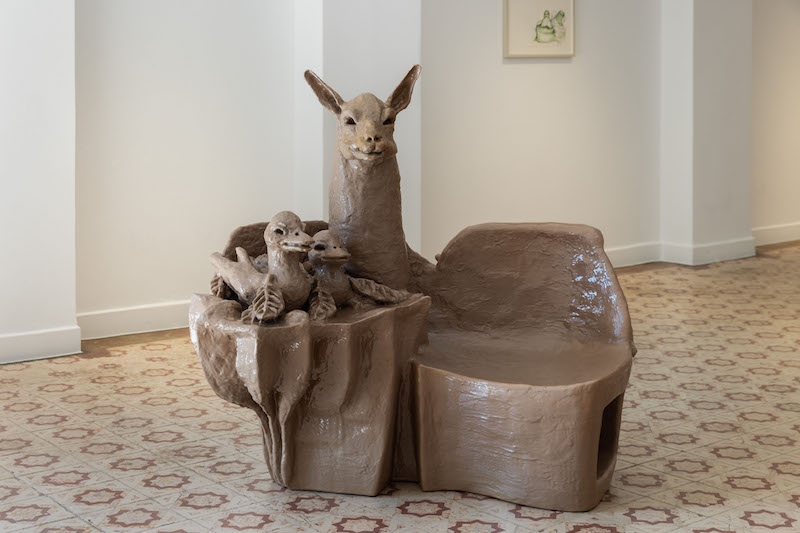
Nuri Koerfer: ‘Thron (lama and quack quack),’ 2023, styrofoam, papier-mâché, resin, 120 x 126 x 70 cm // Courtesy of the artist and Melas Martinos
Gabriela Acha: Your sculptures depict mainly animal busts—ducks, donkeys, crocodiles, llamas—in a way that made me think of a big-scale version of decorative porcelain items. These items are usually small and often considered ornamental or crafty, rather than strictly artistic. But then there is the porcelain manufacturer Meissen, which produces upscale decorative figurines that could resemble fine art objects in their rare essence (and their price). How do you envision your work and practice in this framework?
Nuri Koerfer: Yes, I love these objects people collect. Nearly everyone has something they keep from a trip or an object they have from their grandparents or parents or their childhood, which becomes a piece of the puzzle that makes up our psyche or inner world. I am interested in our relationships with these sometimes arbitrary objects and the importance we give to them.
Animals are super sensitive creatures; through their senses, they bring us back to who we are. I had some form of encounter with most of the animals I use, and I think many people have these kinds of encounters with animals through which they will build their own stories around the sculptures. At the moment, I see many rabbits in the park on my way to the studio, and there are many birds, like red kites, which I see from my studio window. I love these kinds of everyday encounters.
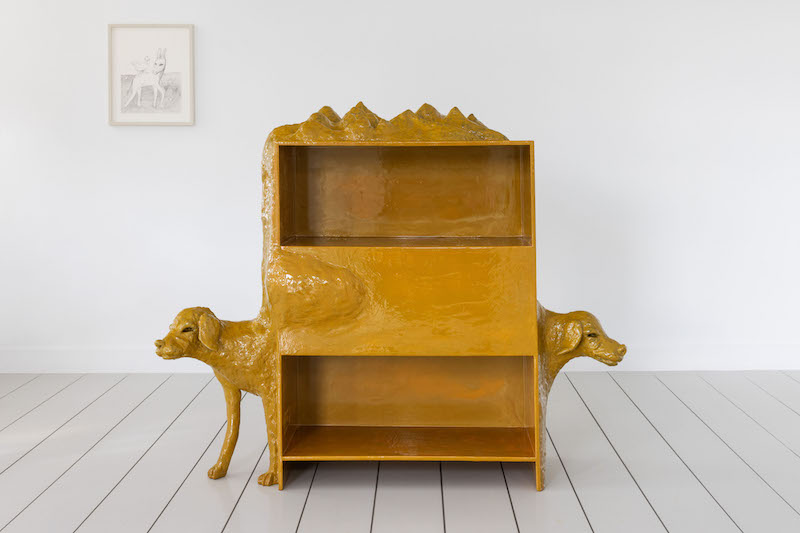
Nuri Koerfer: ‘Gestell (shelf, dogs and alps),’ 2023, wood, papier-mâché, resin, 126 x 153 x 50 cm // Courtesy of the artist and Melas Martinos
GA: It seems that your animals have been relocated from their natural habitat into an artificial one, the exhibition space. Similarly, the “furniture-esque” nature of the sculptures places them outside the traditional realm of art objects. How do you connect your work with these different spaces?
NK: For me, it is important that people live with my work and use it. For example, in the throne works, I am interested in how people sit next to the animals and experience the sculptures up close, becoming part of the work and embodying it. The shelf works become complete when someone has them in their house and puts the objects they decide to live with on the shelves. I have this one shelf I built years ago in my house, and it has shoes inside and stands by the entrance; every day, it looks different, depending on which shoes were put to use on that day and how they were put back after use.
In that sense, I never just made works for the white cube, but like when my works were shown, for example, in the garden of the Brücke Museum. Or, at my more recent show at Melas Martinos in Athens, where, in addition to the dedicated and more formal white exhibition spaces, I used the balcony where I showed a dog bench out of bronze, accompanied by some smaller duck sculptures.
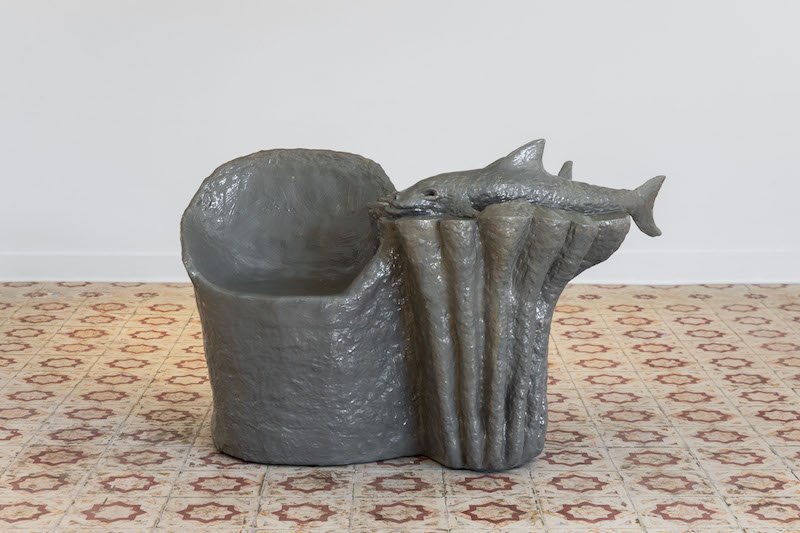
Nuri Koerfer: ‘Thron (fish),’ 2023, styrofoam, papier-mâché, resin, 76 x 126 x 65 cm // Courtesy of the artist and Melas Martinos
GA: The first time I heard about your work was in the context of the project space Mavra that you ran with two peers, and the exhibition ‘Sitting Bone’ you curated there, revolving around sitting devices. The show included, for example, H. R. Giger. Can you talk a bit about how this interest plays into your current sculptural approach?
NK: Mavra is an exhibition space I ran between 2015-2019, with Mark Soo and Julian Stalbohm, here in Berlin. For the ‘Sitting Bone’ exhibition, we put together works from artists who made works to sit on, like a chair by Hans Ruedi Giger, one wooden bench by Klara Lidén and a row of aeroplane seats on wheels, made by Jana Euler. In addition, we had two Sarah Lucas prints with chairs on them.
This was an important show for me, as I was already making all these chair works myself. The first sitting objects I made were called islands, and I saw them as these small little worlds on which you could sit and be safe, so they are a bit more like a small safe space for me. All of them were made so that you have quite a big surface where you can sit comfortably with your legs crossed, so physically comfortable and accessible.
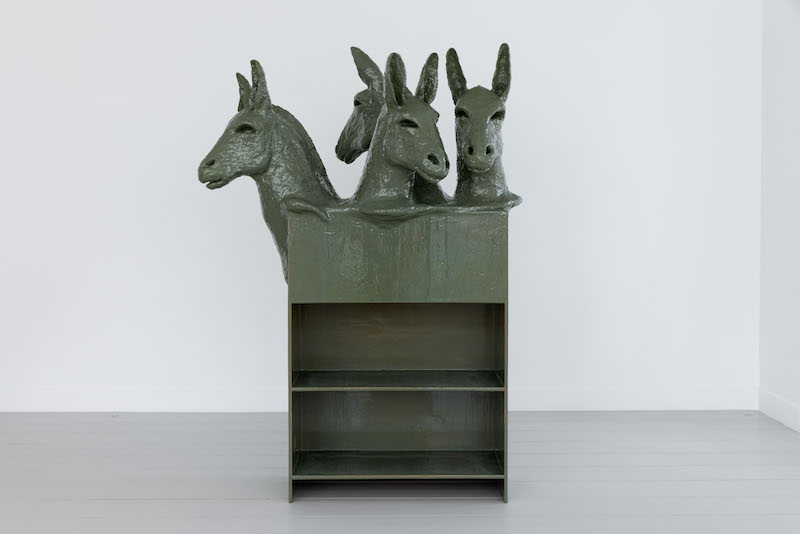
Nuri Koerfer: ‘Gestell (shelf, four donkeys),’ 2023, wood, papier-mâché, resin, 180 x 130 x 90 cm // Courtesy of the artist and Melas Martinos
GA: You usually use styrofoam, papier maché, wood and resin for your sculptures. The styrofoam and paper maché give a deliberate lightness to the works, yet their not-so-sustainable nature makes you reconsider your material approach. Could you expand on that?
NK: Yes, I’m trying to build sculptures I can handle as an artist in the studio. Since I make them from scratch, they must be light but stable enough to hold the weight of a body or books. Sometimes, they have a little styrofoam, but mainly, there is paper and wood inside, and then they are covered with resin. Resin is a natural material, but the hardener I have to mix it with is unsuitable for the environment. I would very much love to change that, but until now, I have not found a solution. Did you know that artificial materials like plastic were developed because people did not want to use elephant teeth and whale bones to make things like hair combs or billiard balls?
I know, for example, a lot of kids’ plates are made out of bamboo that doesn’t break. They often say it’s a natural material, but when you look into the actual composition, there is still resin. I looked into it because I would like to find something solid and finished, and it may exist, but I have been to so many places and read books, but they don’t seem to be there yet.
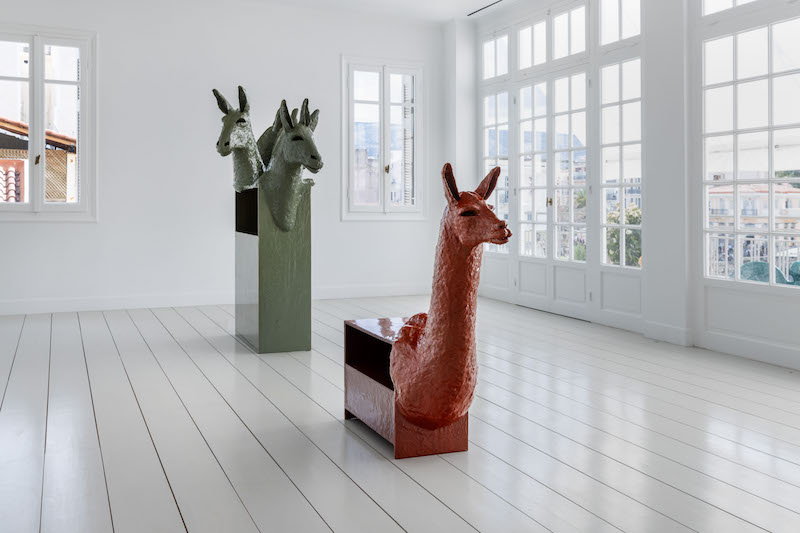
Nuri Koerfer: ‘Duck Down,’ 2024, installation view at Melas Martinos // Courtesy of Melas Martinos
GA: Kids were playing with the works when I visited your last exhibition, ‘Duck Down,’ at Melas Martinos. I was informed that such an outcome was expected and desired, and overall, the works are meant to be moved around or integrated into the domestic setting by being used as furniture by their collectors. What’s your thinking around that?
NK: Yes, this is the final stage, where the sculptures take on a life of their own. People explore the work, sit down and enjoy being next to the animals, or at the same height. I have collectors sending me photographs of their house cat or themselves in, for example, their pyjamas, sitting in my works. This is, for me, the most beautiful part, where the works transcend from being just viewed and becomes animated by the audience. It’s like a small performance happening with each visitor.
Exhibition Info
Art Basel Paris
Galerie Lars Friedrich: Nuri Koerfer
Art Fair: Oct. 18-20, 2024
artbasel.com
Grand Palais, Av. Winston Churchill, 75008, Paris, France, click here for map



















